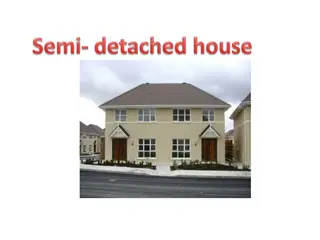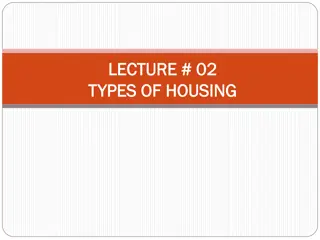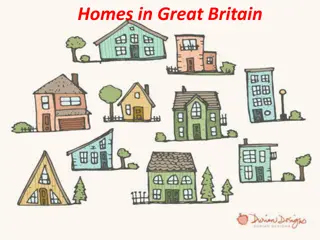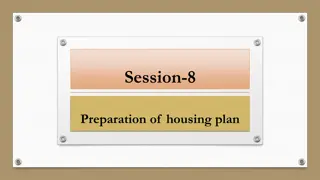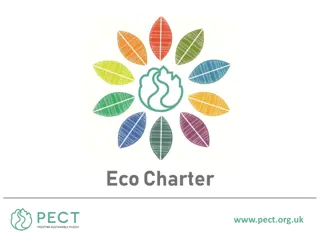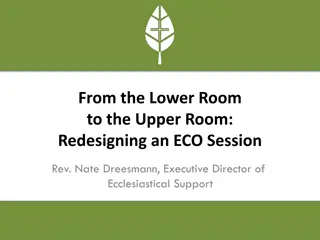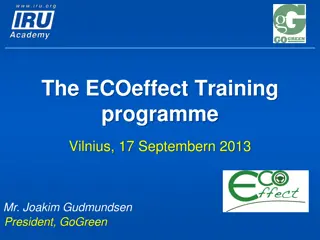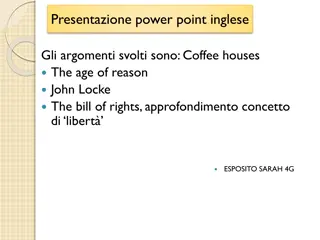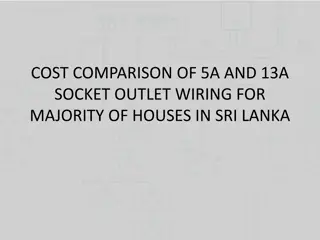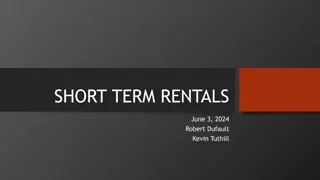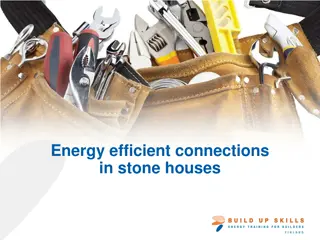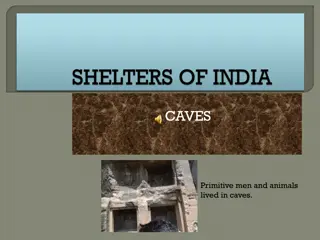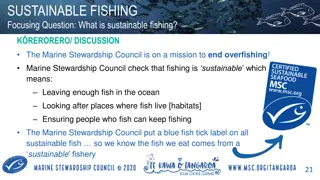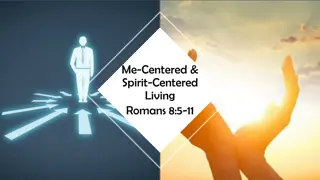Exploring Features of Eco-Houses for Sustainable Living
Eco-houses are designed to minimize energy consumption and waste through features like draught proofing, cavity walling, double-glazed windows, and more. This task involves researching and designing aspects of eco-houses in groups, creating a detailed plan with labeled features, preparing a presentation, and designing a leaflet to sell the eco-house. Insulation plays a crucial role in saving energy and creating a healthier indoor environment. Draught proofing, highlighting the importance of blocking unwanted gaps, is a cost-effective method of energy conservation in buildings.
Download Presentation

Please find below an Image/Link to download the presentation.
The content on the website is provided AS IS for your information and personal use only. It may not be sold, licensed, or shared on other websites without obtaining consent from the author. Download presentation by click this link. If you encounter any issues during the download, it is possible that the publisher has removed the file from their server.
E N D
Presentation Transcript
Eco House What is an Eco-House? An eco house is built in such a way that reduces energy consumption and waste Task In this task you will find out about eco houses and consider the features that you would like to see included in a family house. Working in groups you will need to divide up the research whilst working together on a single design for your house. Contents of Help Pack 1. Tasks Once the information has been collected, each group must decide how best to present their design for the eco house. 2. Introduction 3. Draught Proofing 4. Cavity Walling 5. Double Glazed Windows 6. Hot water tank and piping insulating 7. Loft insulation 8. Insulated Flooring 9. Others areas of Research 10. How to draw a housing plan
Eco House You have 90mins What you need to do. 1. Divide up the tasks between the people in your group. (Use sheet). Each person has a task but its important you keep feeding back to the architects (people drawing the house) 2. Use the research information in this booklet plus anything that you can find on the internet (you are provided with 2 laptops) to make decisions on what features you would like in your eco-house. 3. Draw your eco-house, including a detailed plan with all the features labelled on it and information on what they do and how they work (Use how to draw a building plan). The features labelled should be explained on the plain A4 pieces of paper that accompany the plan. 4. Prepare an estate agent leaflet selling your eco-house 5. Put together a short 3min presentation that you will give to the rest of the class. Tasks 1. Researching and designing cavity walls 2. Researching and designing floor Insulation and draught proofing 3. Researching and designing double glazing 4. Researching and designing loft insulation 5. Researching and designing hot water tank insulation and piping 6. Researching other technologies Use the student group sheet to make sure you assign all tasks and cover everything required. (Some people could have more than one job)
Introduction Why Insulate your house? Insulating your home will save energy and provide a healthier and more comfortable indoor environment. In Winter the heat captured from the sun or generated by your heater needs to be stopped from escaping through walls, ceilings and floors. In summer, insulation will keep the heat out, making your home cooler. Costs and Savings The initial investment of installing insulation will pay off over time because you save money in energy bills. How does insulating work? Most insulation works by trapping air spaces we call these spaces cavities. The smaller the cavities of trapped air, the better the insulation material will work. Good examples in nature are animal shelters, such as bird s nests, which have the ability to keep eggs and young birds at an even temperature in extreme weather conditions. The birds themselves have an added layer of insulation provided by their feathers. Humans have learned from nature s example and clothes have been used for thousands of years to provide warmth. We can insulate our homes by providing spaces of still air, such as in wall insulation or double-glazing. This reduces heat transfer because air is a poor conductor of heat. Another method is to use surfaces that reflect heat, such as silver foil behind radiators.
Draught Proofing The Basics Draught proofing is one of the cheapest and most efficient ways to save energy in any type of building, from a flat to a mansion but it s often overlooked. To draught proof your home you should block up unwanted gaps that let cold air in and warm air out. By saving warm air you ll use less energy to heat your home. What Can be Draught Proofed? Windows Doors Chimneys and fireplaces Floorboards and skirting boards Loft hatches Pipe work Old extractor fans Cracks in walls The savings Full draught proofing will save on average 25 per year. Blocking gaps around skirting boards and floor boards could save another 20 per year. Draught-free homes are comfortable at lower temperatures so you ll be able to turn down your thermostat. This could save you another 55 per year. Useful Website http://www.energysavingtrust.org.uk/Home-improvements-and-products/Home- insulation-glazing/Draught-proofing
Cavity Walling The Basics Home built from 1920 onwards have external walls that are made of two layers with a small gap or cavity between them. This means they have 'cavity walls'. Insulating your cavity walls means filling that gap - with very good reason. No heat can now be transferred by convection because the air has been replaced by insulating materials. Conduction is very poor because both the insulating material and the trapped air are good insulators. The room in the house stays warmer for longer ? Did you know that around a third of all the heat lost in an un-insulated home is through the walls? Insulating cavity walls reduces heat loss and can save you around 110 a year on your fuel bills.
Double Glazing Windows The Basics All properties lose heat through their windows. Installing energy efficient glazing is an effective way of reducing your energy bills and keeping your home warmer and quieter. Double glazed windows use two sheets of glass with a gap between them which creates an insulating barrier, whilst triple glazed windows have three sheets of glass. Both options can deliver a high level of energy efficiency. It is not the case that you have to use triple glazing to gain the most energy efficient window. What it can do Smaller energy bills: replacing all single glazed windows with energy efficient glazing could save you around 130 per year on your energy bills. A smaller carbon footprint: by using less fuel, you ll generate less of the carbon dioxide (CO2) that leads to global warming. A more comfortable home: energy efficient glazing reduces heat loss through windows and means fewer draughts and cold spots. Peace and quiet: as well as keeping the heat in, energy efficient windows insulate your home against unwanted outside noise. Reduced condensation: energy efficient glazing reduces condensation build- up on the inside of windows.
Hot Water Tank and Piping Insulating The Basics Insulating a hot water cylinder is one of the simplest and easiest ways to save energy and money. Fitting a 'jacket' around your cylinder will cut heat loss by over 75%. Both tank and pipe insulation keep your water hotter for longer by reducing the amount of heat that escapes. What the cost? What does it Save? A new, 75mm thick hot water cylinder jacket will save you around 35 per year. The jackets themselves cost less than half that, meaning that you can reclaim your initial cost in less than 6 months. Insulation for hot water pipes will cost around 10 and can save you around 10 a year, which means you should recover the cost of fitting within a year.
Loft Insulation The Basics It's never been more important to think about insulating your loft. Without proper insulation a lot of the valuable, expensive energy you use to heat your home will be lost through the loft. The recommended depth for mineral wool insulation is 270mm however there are other materials which require different depths. Did you know that in an un- insulated home a quarter of your heat is lost through the roof. ? Insulating your loft is a simple and effective way to reduce your heating bills and you can even do it yourself.
Insulated Flooring The Basics Timber floors can be insulated by lifting the floorboards and laying mineral wool insulation supported by netting between the joists. You can also use a regular tube sealant, such as silicon to fill gaps between floorboards and skirting boards to stop draughts. Costs and Savings Using a silicone sealant to fill gaps will save you around 20 a year on your heating bills. Insulating underneath the floorboards on the ground floor will save you around 50 a year. Website http://www.energysavingtrust.org.uk/Home-improvements-and-products/Home- insulation-glazing/Floor-Insulation
Other areas of research As well as managing heat loss in our Eco homes there are also a number of other ways we can make them more environmentally friendly. Use the internet to research some of the following ideas, and decide whether you want to include them in your designs. 1. Solar Roof Panels 2. Roof Gardens 3. Water saving and recycling technologies 4. Wind turbines Website Address Useful Websites http://www.ecohouseagent.com/ http://www.environmentcity.org.uk/article.asp?articleID=120&parentID=1 05 http://www.ecobob.co.nz/EcoArticle/Browse.aspx You could even design your own environmentally friendly idea for you eco house http://www.energysavingtrust.org.uk/Home-improvements/Home- insulation-glazing http://www.smarterhomes.org.nz/
How to draw a building plan When drawing your plan, try and add as much detail as you can, labelling different features, such as double glazed windows and cavity walls. Draw two separate plans, one for downstairs and one for upstairs.




